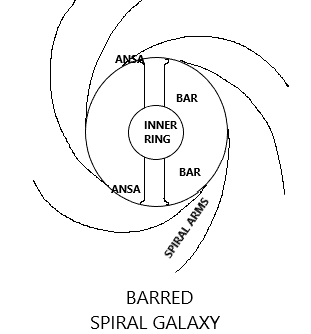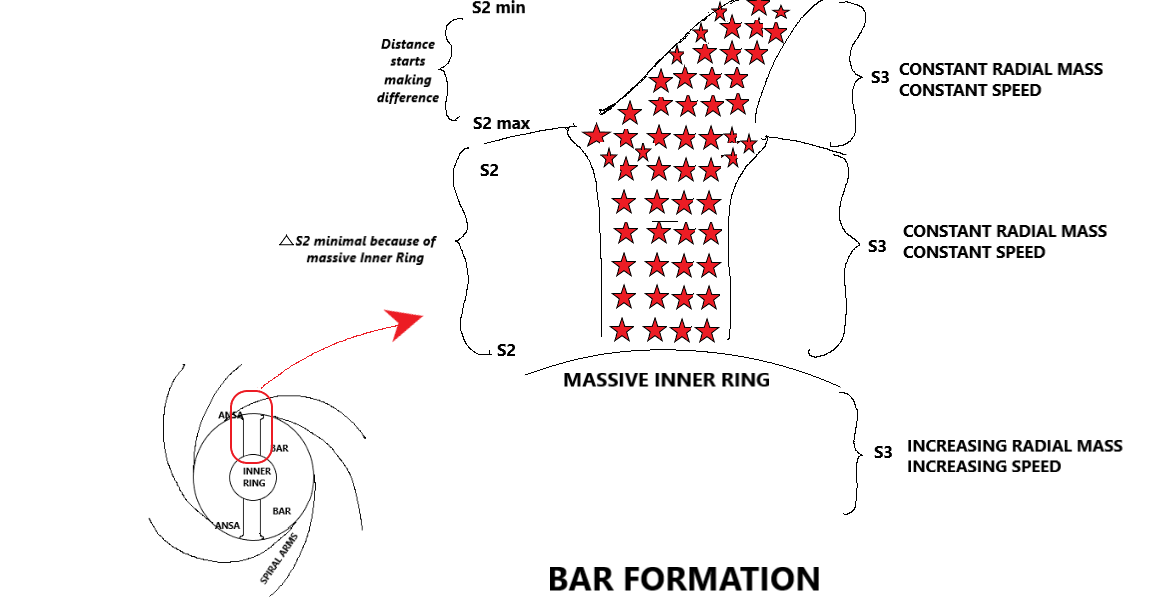SPACITY EXPALINS SPIRAL GALAXY (BARRED)
Spiral Galaxies maybe the norm in the Universe. But all of them are not of similar type. Half of the spiral galaxies observed are Barred type. Our own Milky way is one such type.
In Barred type spiral Galaxies, the spiral arms do not start at the outer edge of the inner ring. The inner ring and spiral arms are separated by a dense band of stars that are confined within a Bar. Thus, named the Barred Spiral Galaxies. There always are two almost identical bars occurring on diagonally opposite sides of the Galaxy.
At the junction between these two Bars and Spiral Arms, there is a dense grouping of stars that look like a loop. Hence named ANSA. These ANSAE are bright and dense.
S2 & S3
Let us apply S2 & S3 of MANTHAN model and seek answers for these questions. How do bars form? Why only two bars? Why on opposite sides? And why Ansae?
How do bars form?
| A Spiral Galaxy has | A Black Hole at the center An Inner Ring of stars Many Spiral Arms |
| A Barred Spiral Galaxy has | A Black Hole at the center An Inner Ring of stars Two bars and Ansae Many Spiral Arms |
How do bars form?
We have already observed the action of S2 and S3 in leading to formation of Spiral Arms. S3 owing to the cumulative star mass in a specific ring keeps them orbiting at constant speed. But it is S2 which is dependent on distance makes the farther band of stars fall back. Thus, creating Spiral Arms.
For the sake of argument let us have a constant S2 up to a limited radius from edge of inner ring. Then the stars in each concentric ring would be moving together. Without falling back. Now compare this situation with Barred Spiral Galaxy. This is what is happening. But why is S2 constant despite the distance increasing. This is only possible in two conditions a) if cumulative star mass increases as radius increases b) If the inner ring is so massive that the change in radius has effect only at a larger distance. The first possibility is not possible since S3 will speed up. So, it should be the massiveness of the inner ring that gives rise to BAR. So, a BAR is born. This Bar gives way to spiral arms when S2 starts getting affected with the distance.
This suggests that Massive or densely packed Inner Rings lead to Barred Spiral Galaxies, while lighter ones limit themselves to Non-Barred Spiral Galaxies. This is in line with the observations.
Why only two bars?
Why are there only two bars and that too diagonally opposite? Why couldn’t there be multiple bars uniformly spaced like spokes of a wheel?
Let us observe what happens when first band of stars form just outside the inner ring. This would disturb the balance of the galaxy. A spinning galaxy is nothing but a galactic Gyroscope. It ensures that the next band of stars is takes shape on the opposite side. Thus, all the stars within the region between inner ring and spiral arms will be banded within these two bars.
Why on Opposite Sides?
The Gyroscopic forces ensure that there are only two bars and that they are on opposite sides of the galaxy. To attain balance.
Why ANSAE?
If left to themselves, the stars in the BAR region would have distributed themselves sparsely. But since due to combined effect of S2 and gyroscopic forces the stars have to be clubbed within the boundary of the bars.
Assume there are no spiral arms on the periphery. Then these widths of the bars would have steadily reduced radially. We would have then had two pointed diagonal spikes outside the inner ring. But the spiral arms have already started forming and have created a barrier at the node of the bars and spiral arm. So, these stars which otherwise would have been part of those pointed spikes have nowhere to go. They have to cram themselves at the edge.
Thus, we see two ANSAE at the edge. Bright and Dense.



0 Comments